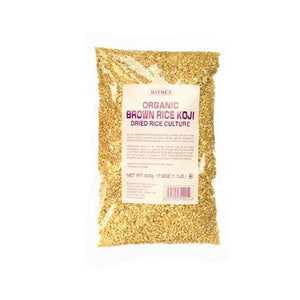
Enjoy soups, marinades and traditional miso sauces without the soy. Chickpeas and brown rice koji give this miso a sweet, nutty flavor. When making miso, it is recommended that all ingredients be measured by weight. Salt especially will vary dramatically depending on coarseness. While the salt may seem excessive compared to vegetable ferments, beans must be salted well to prevent spoilage.
60 minutes
48 minutes
2
INGREDIENTS AND EQUIPMENT AVAILABLE AT CULTURES FOR HEALTH
Organic Brown Rice Koji

Organic Brown Rice Koji
$24.99
This organic brown rice koji is a natural inoculator for making miso, shoyu, and many other Japanese specialty fermented foods. Made in small batches.
INGREDIENTS:
- 500 grams (1 lb) dry chickpeas
- 1 Tbsp. dried seaweed
- 250 grams (or ½ package) brown rice koji
- 2 Tbsp. miso from a previous batch, or purchased raw miso
- ¼ pound salt, plus extra for preparing the culturing vessel
INSTRUCTIONS:
- Soak chickpeas for 10-12 hours. Rinse and drain.
- Combine the soaked beans with seaweed and boil in fresh water until very soft. Alternatively, use a pressure cooker and follow the manufacturer’s instructions.
- Drain the cooked beans and mash until relatively smooth. Some like a very smooth miso, while others prefer to leave some texture.
- Add the salt and distribute evenly.
- When the temperature of the bean mash is below 140°F, stir in the koji and miso.
- To prepare the culturing container, rinse with water and drain, but do not dry. Sprinkle salt liberally inside the container to lightly coat the sides and bottom with salt, to help prevent mold.
- Pack the jar with the bean mixture, adding small amounts at a time, packing well. There should be no air pockets. It helps to pound the container on a hard surface after each addition.
- When the container is full, coat the surface of the miso with salt to form a protective crust. Weigh down the paste, cover the container, and culture in a cool spot for at least 3 months. At temperatures below 65-68°F, miso may take as long as 6 months or more to mature.
- Mold may form on the surface. Scrape it off before storage. Miso can be stored for years, and the flavor will continue to develop. The process can be slowed by refrigeration.

















